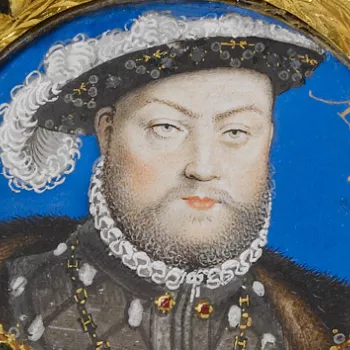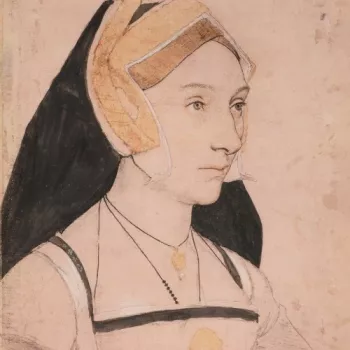Sir Thomas More (1478-1535) 1527
Black and coloured chalks, the outlines pricked for transfer | 39.8 x 29.9 cm (sheet of paper) | RCIN 912268
-
A portrait drawing of Sir Thomas More (1478-1535) The portrait shows his head and shoulders and the sitter faces three-quarters to the right. He wears a hat and fur collar. The drawing has been pricked for transfer. Inscribed in an eighteenth-century hand at upper left: Tho: Moor Ld Chancelour.
Hans Holbein was born in Augsburg, trained in Basel and spent a total of thirteen years in England, in 1526-8 and 1532-43. During the latter period he was the most important artist at the court of Henry VIII, though the English were primarily interested in portraits of themselves - as Anthony Van Dyck was to find a century later - and little survives of Holbein's more varied works in England (such as the lost Triumphs of Riches and Poverty for the Hanseatic merchants' hall). The bulk of the eighty-five portrait drawings now at Windsor were probably in Holbein's studio at his death. They were first documented in 1547 in an album owned by Edward VI, subsequently leaving and re-entering the Royal Collection twice before 1675, with a few losses and additions along the way. About thirty of the drawings can be connected with surviving paintings, and nearly all the remainder were no doubt studies for lost works. In most cases the identity of the sitter is known only from the inscriptions on the drawings, copied - probably in the eighteenth century - from identifications reputedly made by Sir John Cheke, tutor to Edward VI.
Holbein arrived in England in late 1526 with a letter of introduction from Erasmus, addressed to Sir Thomas More (1478-1535), then Speaker of the House of Commons and Chancellor of the Duchy of Lancaster (he was to be appointed Lord Chancellor in 1529). Erasmus and More had been friends and correspondents for many years, part of a close international circle of humanist scholars that also included the Archbishop of Canterbury, William Warham. A portrait of Erasmus painted by Holbein in 1523 had been sent as a gift to Warham, and the artist's abilities would therefore have been known to More before his arrival in England. Holbein probably lodged in More's house in Chelsea throughout his first English sojourn; guild regulations obliged foreign craftsmen to live and work outside the City of London.
The major work of Holbein's first period in England was a portrait of the family of Thomas More, and though this study corresponds with the depiction of More in that painting, it was probably not directly preparatory for it. There are two studies of More at Windsor, both significantly larger in scale than the other six surviving head studies connected with the family group. Both are also close in their details and scale to a portrait of More alone, dated 1527, and it is likely that the studies of Thomas More were drawn in preparation for the single portrait, executed to More's satisfaction before he commissioned the artist to attempt the much more ambitious family group.
Text adapted from Holbein to Hockney: Drawings from the Royal CollectionProvenance
Henry VIII; Edward VI, 1547; Henry FitzAlan, 12th Earl of Arundel; by whom bequeathed to John, Lord Lumley, 1580; by whom probably bequeathed to Henry, Prince of Wales, 1609, and thus inherited by Prince Charles (later Charles I), 1612; by whom exchanged with Philip Herbert, 4th Earl of Pembroke, 1627/8; by whom given to Thomas Howard, 14th Earl of Arundel; acquired by Charles II by 1675
-
Creator(s)
Acquirer(s)
-
Medium and techniques
Black and coloured chalks, the outlines pricked for transfer
Measurements
39.8 x 29.9 cm (sheet of paper)
Markings
watermark: Briquet 1827: three fleurs de lys in a crowned shield [same as 12272,12266]
Object type(s)
Other number(s)
RL 12268












